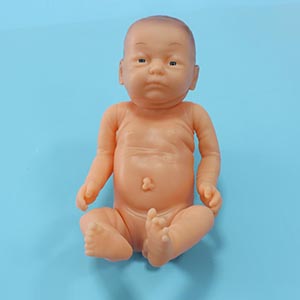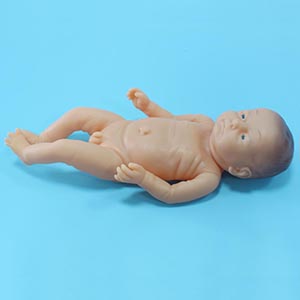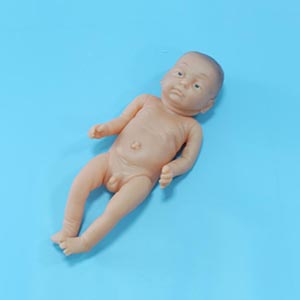07-12-2024
ADA MED SUPPLY LIMITED
Article tag: Full-term infant model Medical Pediatric model BIX-LT1
Neonatal first aid is a highly specialized skill for medical professionals, especially when dealing with first-aid situations for full-term infants. The full-term baby model serves as an important training tool to help medical staff practice critical skills in a risk-free environment. By simulating different first aid situations, students can quickly master the correct steps of newborn first aid and enhance their resilience in stressful situations. So, what role does the full-term baby model play in first-aid training? How can healthcare professionals use these models for training?
Apnea and asphyxia are common emergency situations for newborns, especially in the first few hours after delivery. The full-term baby model is able to simulate the situation of infant apnea and help medical personnel practice how to perform airway management and rescue breathing in emergency situations. Many training models also have a "airway blockage" setting, which simulates a newborn's airway obstruction due to secretions or other causes.

How to operate:
1. Turn the face of the model towards the student to simulate a normal airway or apnea.
2. In a simulated apnea situation, students need to determine whether the baby's airway is open and use an aspirator to clear the airway.
3. If there is still no breathing, the student should perform artificial respiration and chest compressions to ensure effective cardiopulmonary resuscitation (CPR).
According to a study in the Journal of Emergency and Critical Care Medicine (2022), after simulated neonatal emergency training, medical personnel were more than 30% faster in responding to apnea and asphyxia situations in practice, reducing the risk of error.
Neonatal Resuscitation is a basic skill that every neonatal nurse must master. The full-term baby model provides a complete resuscitation training scenario that simulates emergency situations such as hypoxia and cardiac arrest in newborns. In this process, students can practice how to effectively perform artificial respiration, chest compression, drug administration and other operations.
How to operate:
1. Set the model to simulate hypoxia or no respiration.
2. Students choose appropriate first aid measures, such as starting cardiopulmonary resuscitation or using medication, according to the simulated situation.
3. Through repeated practice, students can master the process of neonatal resuscitation and can quickly respond to various emergencies.
According to a study published in the Journal of Neonatal Emergency Training, the success rate of resuscitation for medical professionals increased by 25% through simulation training, and the timeliness and accuracy of resuscitation operations were significantly improved.

In some cases, newborns may asphyxiate due to inhalation of foreign objects (such as amniotic fluid, secretions, etc.). The full-term baby model helps trainees practice airway clearing and suction by simulating airway blockage.
How to operate:
1. The model simulates airway obstruction, which students need to clear with correct techniques.
2. During suction, students can observe whether the model has an effective airway return and verify the correctness of the operation.
3. Students can also simulate how to perform first aid measures such as abdominal pressing or back slapping on the model.
Quote:
According to a 2021 study in the Journal of Neonatal Care and Emergency Care, medical personnel who underwent simulated training experienced a 40% increase in the success rate of neonatal asphyxia emergency care, and the time to successfully complete emergency care was reduced by an average of 20%.
Modern full-term infant training models usually have real-time feedback systems. Through the feedback mechanism, students can quickly know if they are performing first aid operations properly. For example, the model can detect the depth and frequency of chest compressions, or the amount of gas input during mouth-to-mouth resuscitation. This immediate feedback helps participants to continually adjust their techniques to ensure that they are in line with best clinical practice.

How to operate:
1. The model will provide real-time feedback during operations such as CPR or airway clearing.
2. Based on the feedback results, students can adjust the operation intensity, Angle and method to ensure that the skills are up to standard.
3. After each round of operations, students can view the evaluation report generated by the system to understand their strengths and weaknesses in first aid operations.
A 2023 study in the Journal of Simulation Medicine and Emergency Technology showed that training models with real-time feedback significantly improved the accuracy and timeliness of trainees' operations, reducing the error rate by 18%.
First aid for newborns often occurs in emergency situations where medical personnel need to make quick decisions and take appropriate measures. Through repeated training of the full-term baby model, the trainees can improve their emergency response speed and judgment ability, be familiar with every link of the first aid operation, and be more confident and calm in the actual clinical practice.
1. The model sets different first aid situations to simulate emergencies.
2. Students choose appropriate first aid measures according to the situation and learn how to operate in different situations.
3. In the simulated situation, students improve their emergency handling ability by making quick decisions and operations.
Research has shown that medical personnel trained in simulated first aid respond faster to emergency situations and reduce decision times by about 20% (Source: Medical Emergency and Resuscitation, 2022).
The role of full-term baby model in neonatal first aid training should not be underestimated. It not only provides an efficient learning platform for medical professionals, but also helps trainees to improve their skills and confidence through repeated practice in a risk-free environment by simulating real first aid situations. Whether dealing with apnea, resuscitating a newborn, or responding to emergencies such as asphyxia, the full-term baby model can effectively enhance the first-aid capabilities of medical personnel. Through the continuous simulation training, the students can master the neonatal first aid skills more skillfully, and then lay a solid foundation for the emergency response in the actual clinical work.